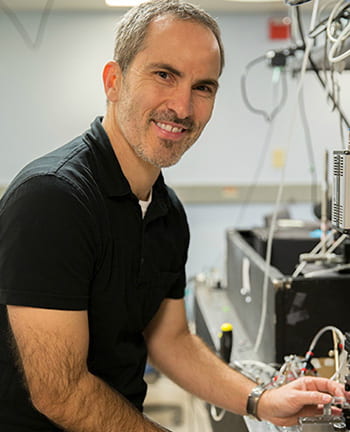Programmable device enables on-demand delivery of individual biomolecules with feedback-controlled gating for high-throughput analysis
UCSC | Tim Stephens| August 16, 2019
A new chip-based platform developed by researchers at UC Santa Cruz integrates nanopores and optofluidic technology with a feedback-control circuit to enable an unprecedented level of control over individual molecules and particles on a chip for high-throughput analysis.
In a paper published August 16 in Nature Communications, the researchers reported using the device to control the delivery of individual biomolecules—including ribosomes, DNA, and proteins—into a fluid-filled channel on the chip. They also showed that the device can be used to sort different types of molecules, enabling selective analysis of target molecules from a mixture.
The capabilities of the programmable nanopore-optofluidic device point the way toward a novel research tool for high-throughput single-molecule analysis on a chip, said Holger Schmidt, the Kapany Professor of Optoelectronics at UC Santa Cruz and corresponding author of the paper.
“We can bring a single molecule into a fluidic channel where it can then be analyzed using integrated optical waveguides or other techniques,” Schmidt said. “The idea is to introduce a particle or molecule, hold it in the channel for analysis, then discard the particle, and easily and rapidly repeat the process to develop robust statistics of many single-molecule experiments.”
The new device builds on previous work by Schmidt’s lab and his collaborator Aaron Hawkins’ group at Brigham Young University to develop optofluidic chip technology combining microfluidics (tiny channels for handling liquid samples on a chip) with integrated optics for optical analysis of single molecules. The addition of nanopores allows controlled delivery of molecules into the channel, as well as the opportunity to analyze the electrical signal produced as a molecule passes through the pore. This latest work was led by first author Mahmudur Rahman, a graduate student in Schmidt’s lab at UC Santa Cruz.
Nanopore technology has been successfully used in DNA sequencing applications, and Schmidt and other researchers have been exploring new ways to exploit the information in the signals produced as molecules or particles translocate through a nanopore.
[ Read more… ]

